 Atlas, Boston Dynamics' humanoid research platform, is all scratched up after some parkour practice.Boston Dynamics
Atlas, Boston Dynamics' humanoid research platform, is all scratched up after some parkour practice.Boston Dynamics This will buff out, right?Boston Dynamics
This will buff out, right?Boston Dynamics I'm no expert, but that doesn't look good.Boston Dynamics
I'm no expert, but that doesn't look good.Boston Dynamics How do you move around a 190-pound robot when it's shut off? Just use what looks like a tall car engine crane.Boston Dynamics
How do you move around a 190-pound robot when it's shut off? Just use what looks like a tall car engine crane.Boston Dynamics In the repair shop, engineers wrench on the broken Atlas until it works.Boston Dynamics
In the repair shop, engineers wrench on the broken Atlas until it works.Boston Dynamics The repair shop has an overhead track that Atlases are suspended from for easy movement.Boston Dynamics
The repair shop has an overhead track that Atlases are suspended from for easy movement.Boston Dynamics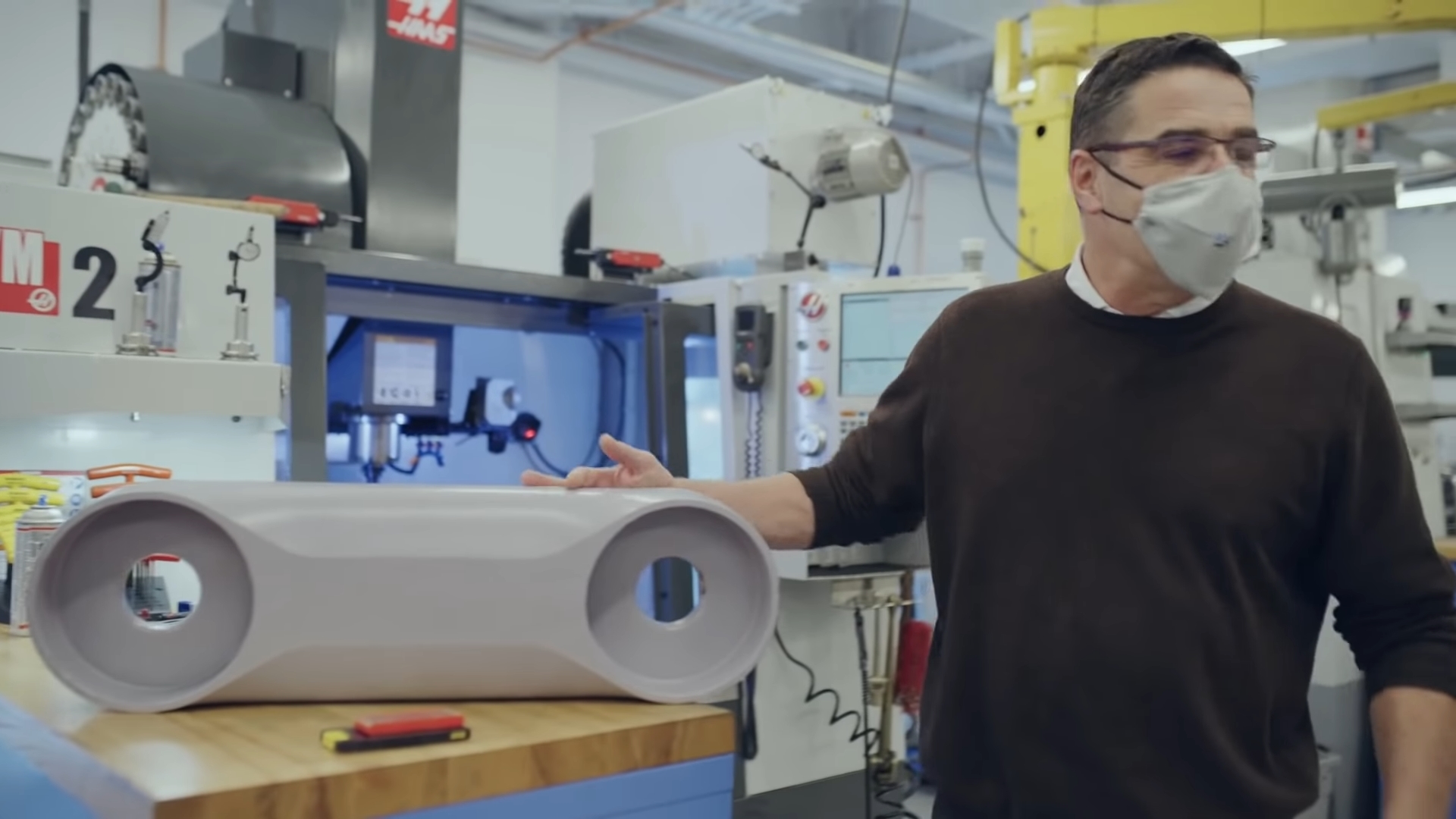 We need a new part! Boston Dynamics has a whole CNC setup so it can make parts like this. (Though this particular part seems too big to be part of Atlas.)Boston Dynamics
We need a new part! Boston Dynamics has a whole CNC setup so it can make parts like this. (Though this particular part seems too big to be part of Atlas.)Boston Dynamics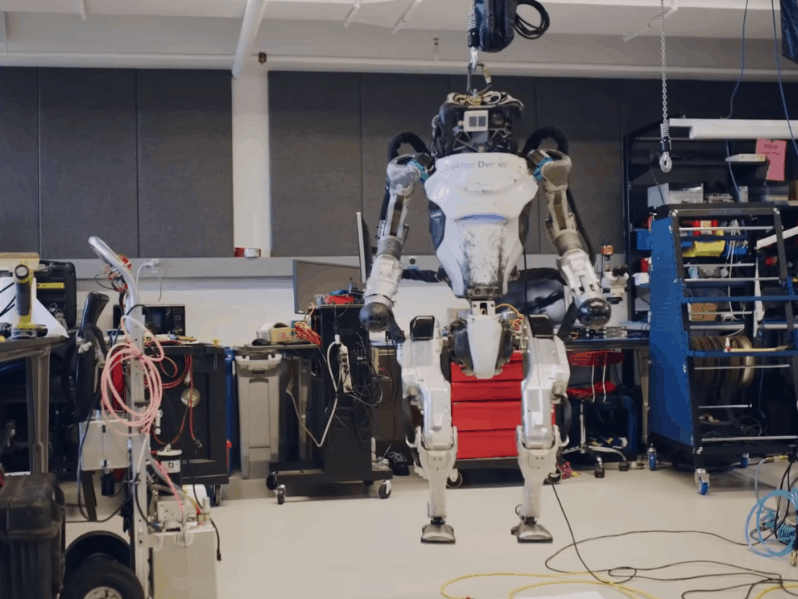 After some repairs, Atlas passes a systems check. Engineers are happy.Boston Dynamics
After some repairs, Atlas passes a systems check. Engineers are happy.Boston Dynamics
New Boston Dynamics video alert!
The robot developer and YouTube sensation is giving us another peek at its robot-building efforts, this time by having its humanoid robotics research platform, Atlas, do some more parkour. Besides releasing a highly polished video, the company also posted a behind-the-scenes look at what it takes to get a robot to jump through an obstacle course. It's the best look at Atlas we've gotten yet and shows incredible footage of manufacturing, software, and repairs—plus some gnarly wipeouts when the stunts don't go according to plan.
This is the third video we've seen of Atlas doing parkour, and you might wonder why Boston Dynamics is so obsessed with making its robots jump on boxes and do backflips. Atlas does parkour for the same reason car companies do motorsports. Using sports to push the performance boundaries of a machine leads to the development of better parts and techniques, and the tests have a trickle-down effect for consumer products. Just as motorsport has led to the creation of all-wheel drive, disc brakes, and tons of safety features for production cars, teaching Atlas to do backflips will hopefully result in better robots from Boston Dynamics.
Atlas Team Lead Scott Kuindersma starts off the video with some Atlas stats. The robot is 5 feet tall and weighs 190 lbs. It is battery-powered and hydraulically actuated, with 28 degrees of freedom. Kuindersma also gives a sales pitch for parkour testing:
Parkour is a useful organizing activity for our team because it highlights several challenges that we believe to be important. First, how do we build a high-power-density mobile robot that's capable of extended athletic behavior? How do we design control algorithms that can create a variety of behaviors and control them robustly? And how do we connect perception to action in a way that both captures long-term goals like getting from point A to point B and short-term dynamic goals like adjusting footsteps and applying corrective forces to maintain balance?
Unlike the previous two videos, which showed one-off tricks, the new video shows Atlas doing an entire obstacle course in one go, which the company says helps with reliability and repeatability. Trying to get through a whole obstacle course leads to a lot of failures and helps the hardware and software teams track down what "strategic upgrades" need to be made to help the robot get through the course.
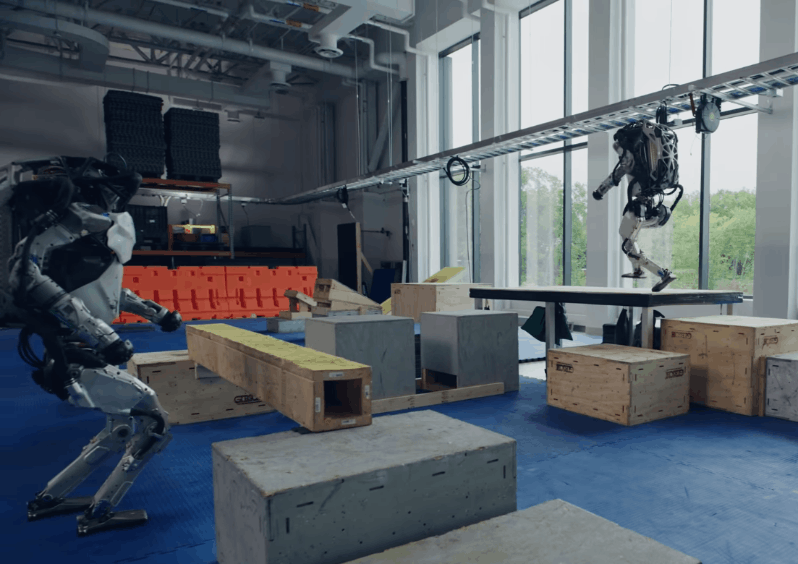 This GIF shows what is probably the most impressive part of the video. Look at the small corrections Atlas is constantly making. As it leaps over the bar, its supporting arm wiggles under the stress. Atlas has a small stumble on the box landing and has to throw its arms back and lift a foot to maintain balance.Boston Dynamics
This GIF shows what is probably the most impressive part of the video. Look at the small corrections Atlas is constantly making. As it leaps over the bar, its supporting arm wiggles under the stress. Atlas has a small stumble on the box landing and has to throw its arms back and lift a foot to maintain balance.Boston Dynamics
While Atlas' hardware doesn't look too different from its previous appearances, the robot seems to move differently now, thanks to what looks like a dramatic upgrade to its small corrective movements. Older videos show what looks like a heavier, stiffer robot, but today, Atlas can flail its arms and legs around to adjust balance and trajectory mid-stunt.
The arm-flailing not only makes some of the failed stunts look hilarious (we made a whole gallery of these instances below), but they also presumably add a human-like margin of error for stunts. The robot doesn't have to do things perfectly anymore. If Atlas only manages a shaky gymnastics routine that would get a 7-out-of-10 from the judges, the robot can swing its weight around accordingly, try to recover, and move on to the next part of the routine.
We highlighted the shakiest bit of movement in the GIF above. Atlas vaults over a bar, and its supporting arm twitches the entire time. Boston Dynamics' blog post points out that this maneuver is actually pretty difficult for Atlas because its arms aren't that strong compared to its heavy body. Apparently, this stunt represents the limit of what the robot can do.
Atlas' movement is now driven by perception. Previously, the robot only did pre-programmed parkour on a flat surface or stationary boxes, but Atlas is now detecting the environment with RGB cameras and depth sensors and reacting to it. As the blog post puts it, "This means the engineers don’t need to pre-program jumping motions for all possible platforms and gaps the robot might encounter. Instead, the team creates a smaller number of template behaviors that can be matched to the environment and executed online." Three on-board computers handle all the computation needed to perceive the world around Atlas, plot a course, and keep the robot upright.
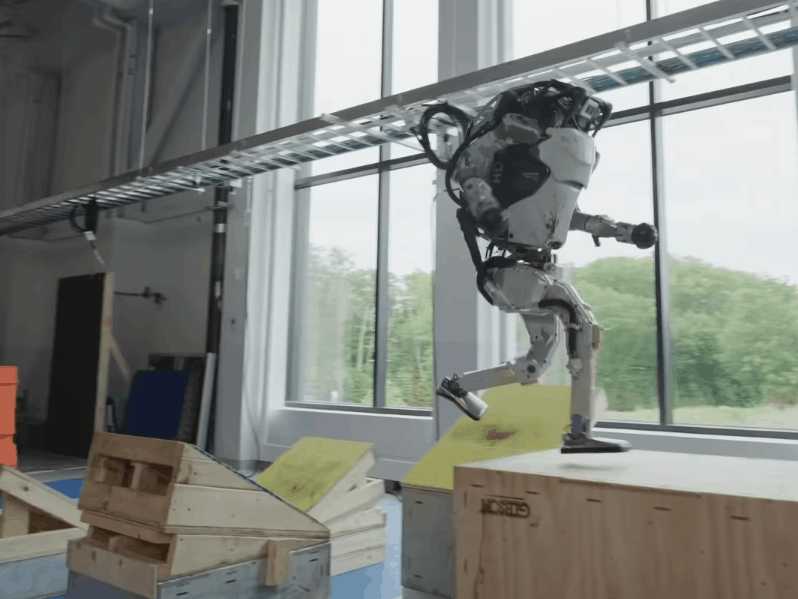 A GIF gallery of Atlas slams. Can robots feel pain? I hope not.Boston Dynamics
A GIF gallery of Atlas slams. Can robots feel pain? I hope not.Boston Dynamics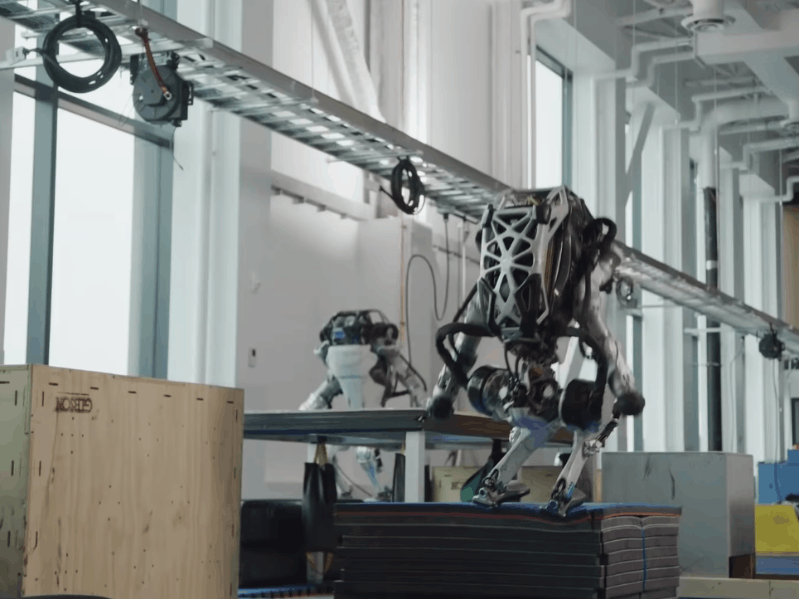 That's going to leave a mark.Boston Dynamics
That's going to leave a mark.Boston Dynamics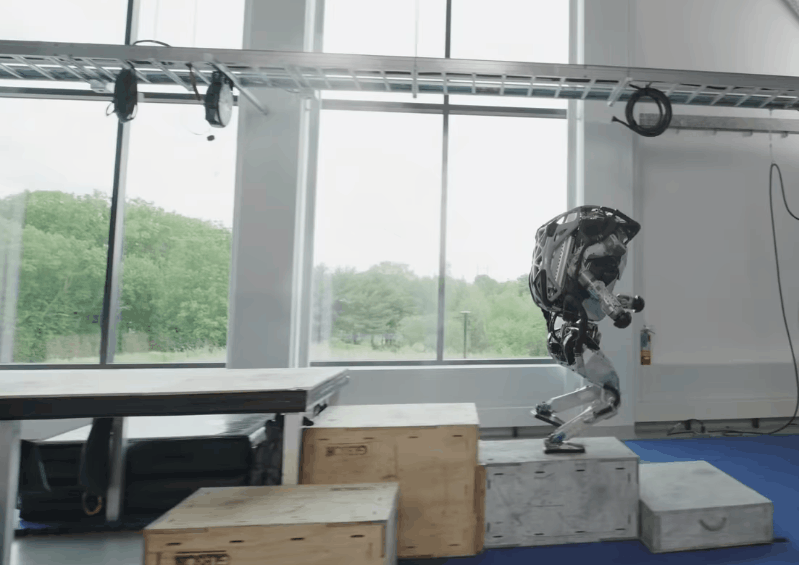 Atlas has a hydraulics blowout and goes down.Boston Dynamics
Atlas has a hydraulics blowout and goes down.Boston Dynamics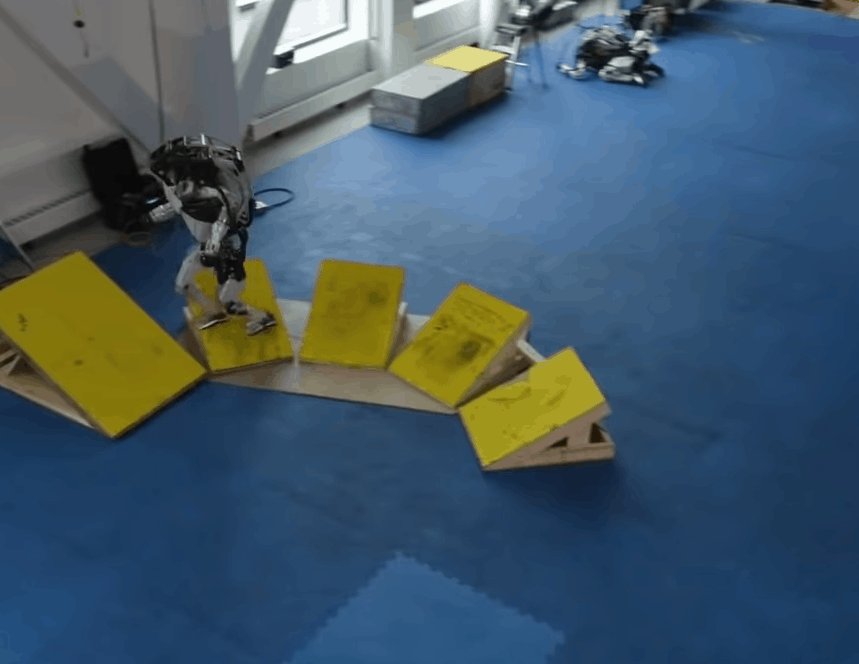 Here, I think Atlas' foot gets caught on the side of a box.Boston Dynamics
Here, I think Atlas' foot gets caught on the side of a box.Boston Dynamics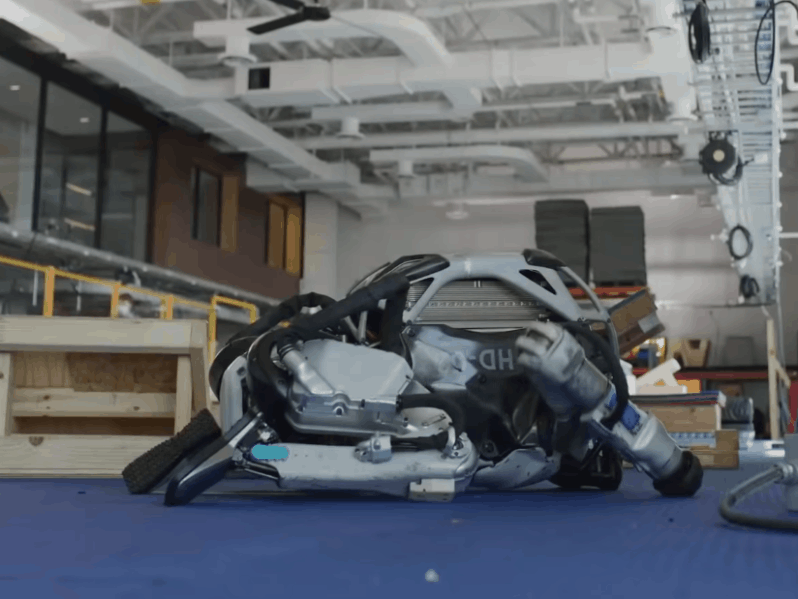 It doesn't matter if you fall, Atlas. What matters is that you get back up.Boston Dynamics
It doesn't matter if you fall, Atlas. What matters is that you get back up.Boston Dynamics
This kind of behind-the-scenes video is something Boston Dynamics hasn't done before, and it's a great watch. You'll see Atlas take all kinds of bumps and bruises along the way, just like an X Games athlete training to do a stunt course. At one point, the robot misses a jump and does a hard face plant into the next platform. While running through the course, the robot has what looks like a hydraulics line blowout, which sprays fluid all over the place as Atlas collapses to the ground in a heap. Another time, a platform gives out under Atlas' weight right as it's attempting a backflip, and the robot lands right on its head. Brutal.
Part of the reason the slams look so bad is that Atlas doesn't seem to have any kind of fall detection yet. Humans have an involuntary fall-detection routine—usually, you'll stick your arms out and try to catch yourself while falling. But Atlas just slams face-first into things.
The video also shows what life in the robot repair shop is like. Engineers drag disabled robots around on overhead cranes, huge CNC machines produce new parts, and everything gets tested before it's back to work for Atlas. After a lot of practice, corrections, and upgrades, you get a run that looks like this:
"behind" - Google News
August 17, 2021 at 11:40PM
https://ift.tt/3gcBtpj
Boston Dynamics shares an incredible behind-the-scenes look at robot-building - Ars Technica
"behind" - Google News
https://ift.tt/2YqUhZP
https://ift.tt/2yko4c8
Bagikan Berita Ini














0 Response to "Boston Dynamics shares an incredible behind-the-scenes look at robot-building - Ars Technica"
Post a Comment